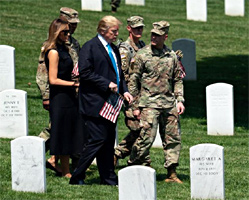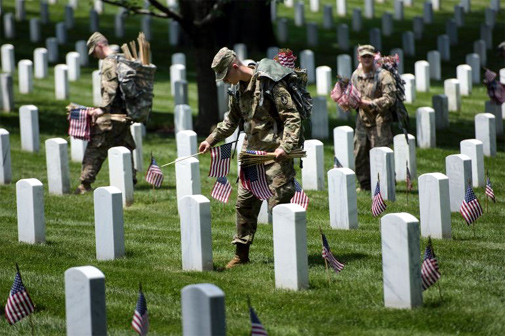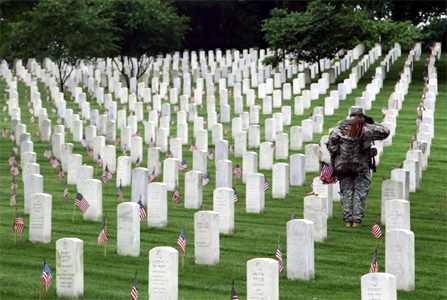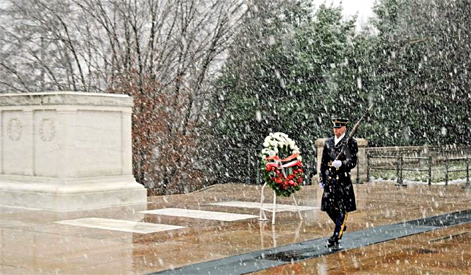Up-dated: 9:30 p.pm., May 23, 2019
 Added: Donald Trump, Melania pay visit to Arlington Cemetery ~
Added: Donald Trump, Melania pay visit to Arlington Cemetery ~
President Donald Trump and first lady Melania Trump paid their respects to fallen American troops during an unannounced visit to Arlington National Cemetery ahead of Memorial Day […]
Presidents typically lay a wreath and deliver remarks at the cemetery on Monday, which is Memorial Day, but Trump will be in Japan on a state visit.
~~~~~~~~~~~~
At Arlington National Cemetery, the Thursday before Memorial Day is known as “Flags In” day ~
For more than 60 years, the 3rd U.S. Infantry Regiment (The Old Guard) has honored America’s fallen heroes by placing American flags at gravesites for service members buried at both Arlington National Cemetery and the U.S. Soldiers’ and Airmen’s Home National Cemetery just prior to the Memorial Day weekend.
This tradition, known as ‘Flags in,’ has been conducted annually since The Old Guard was designated as the Army’s official ceremonial unit in 1948. Every available soldier in the 3rd U.S. Infantry Regiment participates, placing small American flags at each headstone and at the bottom of each niche row.
Senator Tom Cotton (R-AK), who served with the Army in Iraq and Afghanistan, shared his experience with the Arlington flag duty during a speech he delivered at Hillsdale College’s Allan P. Kirby, Jr. Center for Constitutional Studies and Citizenship in Washington, D.C.. The precision required to plant every small flag, at exactly one boot-length from each headstone, necessitates that a soldier complete an entire row of graves – so the distance remains consistent ~
(O)therwise, different boot sizes might disrupt the perfect symmetry of the headstones and flags. I planted flag after flag, as did the soldiers on the rows around me.
Bending over to plant the flags brought me eye-level with the lettering on those marble stones. The stories continued with each one. Distinguished Service Cross. Silver Star. Bronze Star. Purple Heart. America’s wars marched by. Iraq. Afghanistan. Vietnam. Korea. World War II. World War I. Some soldiers died in very old age; others were teenagers. Crosses, Stars of David, Crescents and Stars. Every religion, every race, every age, every region of America is represented in these fields of stone.
I came upon the gravesite of a Medal of Honor recipient. I paused, came to attention, and saluted. The Medal of Honor is the nation’s highest decoration for battlefield valor. By military custom, all soldiers salute Medal of Honor recipients irrespective of their rank, in life and in death. We had reminded our soldiers of this courtesy; hundreds of grave sites would receive salutes that afternoon. I planted this hero’s flag and kept moving.
Cotton also discusses the distinguished history of The Old Guard; the 3rd United States Infantry Regiment ~
The Old Guard is literally the old guard, the oldest active-duty infantry regiment in the Army, dating back to 1784, three years older even than our Constitution. The regiment got its nickname in 1847 from Winfield Scott, the longest-serving general in American history. Scott gave the regiment the honor of leading the victory march into Mexico City, where he directed his staff to “take your hats off to The Old Guard of the Army.” Perhaps Scott felt an old kinship with the 3rd Infantry, because he had fought the British alongside them outside Niagara Falls during the War of 1812.
Over time it became the solemn responsibility of The Old Guard to honor the service of our fallen warriors. Just reading about the regiment’s long-standing commitment to military traditions brought a tear to my eye, and made me proud to be an American ~
Since 1948, when The Old Guard became the Army’s ceremonial unit and official escort to the president, it has marched in inaugural parades, performed ceremonies at the White House and the Pentagon, and provided color guards and a drill team for events around the capital, among other missions.
But one mission takes priority above all else: military-honor funerals in Arlington National Cemetery. In manning, in training, in operating, funerals always come first, and they are a no-fail, zero-defect mission. While we often performed more than 20 funerals a day, we knew that—for the fallen and the family—each funeral was a once-in-a-lifetime moment, a lifetime in the making.
No matter how often we conducted funerals—and most of us performed hundreds of them—the pressure to achieve perfection for the fallen and their families never relented.
At the end of his talk, Cotton shared an anecdote that demonstrates the unique gratitude that most Americans feel for those who have served in the military, and the reverence they have for the fallen ~
No one summed up better what The Old Guard of Arlington means for our nation than Sergeant Major of the Army Dan Dailey. He shared a story with me about taking a foreign military leader through Arlington to lay a wreath at the Tomb of the Unknown Soldier. Sergeant Major Dailey said, “I was explaining what The Old Guard does and he was looking out the window at all those headstones. After a long pause, still looking at the headstones, he said, ‘Now I know why your soldiers fight so hard. You take better care of your dead than we do our living.’”







